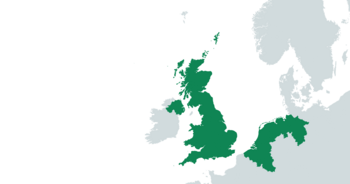Hanoverian Union: Difference between revisions
No edit summary |
No edit summary |
||
| Line 96: | Line 96: | ||
}} | }} | ||
The '''Hanoverian Union''', formally the '''Union of Hanoverian Nations''' is a politico-economic union consisting of three neighbouring countries in {{wp|Western Europe}}, namely the {{wp|United Kingdom}}, the {{wp|Netherlands}}, and {{wp|Luxembourg}}, all three of which are constitutional monarchies with a single {{wp|House of Hanover|Hanoverian}} monarch as their respective head of state, currently [[Alexandra of the United Kingdom and of the Netherlands|Queen/Grand Duchess Alexandra]]. Formed in 1946 as a result of the {{wp|Brussels Agreement}} between the governments of all three countries, the organisation mainly promotes intergovernmental cooperation between its three member states, with the reigning {{wp|House of Hanover|Hanoverian}} monarch being promoted and seen as a common and unifying identity between the three countries. With an estimated total population of 106 million, the union covers a total area of approximately 365,754.4 km2 (141,218.6 sq mi) | The '''Hanoverian Union''', formally the '''Union of Hanoverian Nations''' is a politico-economic union consisting of three neighbouring countries in {{wp|Western Europe}}, namely the {{wp|United Kingdom}}, the {{wp|Netherlands}}, and {{wp|Luxembourg}}, all three of which are constitutional monarchies with a single {{wp|House of Hanover|Hanoverian}} monarch as their respective head of state, currently [[Alexandra of the United Kingdom and of the Netherlands|Queen/Grand Duchess Alexandra]]. Formed in 1946 as a result of the {{wp|Brussels Agreement}} between the governments of all three countries, the organisation mainly promotes intergovernmental cooperation between its three member states, with the reigning {{wp|House of Hanover|Hanoverian}} monarch being promoted and seen as a common and unifying identity between the three countries. With an estimated total population of 106 million, the union covers a total area of approximately 365,754.4 km2 (141,218.6 sq mi) while collectively boasting an economy worth $6.025 trillion. | ||
The organisation's agenda is mainly decided and legislated by a legislative body, known as the [[Executive Council of the Hanoverian Union]], which is made up of approximately thirty members with approximately ten seats being allocated to each of the organisation's three member states, whom would appoint members from their own national legislatures to take up their respective allocated seats. By tradition, the [[Executive Council of the Hanoverian Union|Executive Council]] convenes every fifteen years, with each session seeing members of the legislative body voting to enact the organisation's seasonal agenda, known as a "Trinational Plan". | The organisation's agenda is mainly decided and legislated by a legislative body, known as the [[Executive Council of the Hanoverian Union]], which is made up of approximately thirty members with approximately ten seats being allocated to each of the organisation's three member states, whom would appoint members from their own national legislatures to take up their respective allocated seats. By tradition, the [[Executive Council of the Hanoverian Union|Executive Council]] convenes every fifteen years, with each session seeing members of the legislative body voting to enact the organisation's seasonal agenda, known as a "Trinational Plan". | ||
Revision as of 15:51, 1 October 2023
Hanoverian Union
| |||||
|---|---|---|---|---|---|
|
Flag | |||||
| Motto: "Eenheid onder de kroon" (Dutch) "Eenheet ënner der Kroun" (Luxembourgish) "Unity under the Crown" | |||||
| Anthem: "The Anthem of Unity" | |||||
 | |||||
| Administrative center | Brussels | ||||
| Official languages | English, Dutch, Luxembourgish | ||||
| Type | Politico-economic union | ||||
| Membership | United Kingdom Netherlands Luxembourg | ||||
| Leaders | |||||
| Alexandra | |||||
• Chairman | Sigrid Kaag | ||||
| Paulette Lenert | |||||
| David Gauke | |||||
| The Baroness Hale of Richmond | |||||
| Legislature | Executive Council of the Hanoverian Union | ||||
| Establishment | |||||
| 6 December 1946 | |||||
| Area | |||||
• | 365,754.4 km2 (141,218.6 sq mi) | ||||
| Population | |||||
• 2022 estimate | 106,025,548 | ||||
• Density | 289.8/km2 (750.6/sq mi) | ||||
| GDP (PPP) | 2022 estimate | ||||
• Total | $6.025 trillion | ||||
• Per capita | $56,825 | ||||
| GDP (nominal) | 2022 estimate | ||||
• Total | $5.297 trillion | ||||
• Per capita | $49,959 | ||||
| HDI (2021) | very high | ||||
| Currency | Pound sterling (GBP) Euro (EUR) United States dollar (USD) | ||||
The Hanoverian Union, formally the Union of Hanoverian Nations is a politico-economic union consisting of three neighbouring countries in Western Europe, namely the United Kingdom, the Netherlands, and Luxembourg, all three of which are constitutional monarchies with a single Hanoverian monarch as their respective head of state, currently Queen/Grand Duchess Alexandra. Formed in 1946 as a result of the Brussels Agreement between the governments of all three countries, the organisation mainly promotes intergovernmental cooperation between its three member states, with the reigning Hanoverian monarch being promoted and seen as a common and unifying identity between the three countries. With an estimated total population of 106 million, the union covers a total area of approximately 365,754.4 km2 (141,218.6 sq mi) while collectively boasting an economy worth $6.025 trillion.
The organisation's agenda is mainly decided and legislated by a legislative body, known as the Executive Council of the Hanoverian Union, which is made up of approximately thirty members with approximately ten seats being allocated to each of the organisation's three member states, whom would appoint members from their own national legislatures to take up their respective allocated seats. By tradition, the Executive Council convenes every fifteen years, with each session seeing members of the legislative body voting to enact the organisation's seasonal agenda, known as a "Trinational Plan".
Despite its similarities to the Commonwealth of Nations in which several members of the organisation share a common head of state with the United Kingdom, the Netherlands and Luxembourg are generally considered to be distinct from the former in that they are otherwise fully independent sovereign nations rather than former British colonies such as Canada, Australia, and New Zealand.
Formation
The end of the Second World War in 1945, while not completely so, had inflicted considerable damage to the economies of the United Kingdom, the Netherlands, and Luxembourg, with towns and cities damaged by bombings from both sides, and the lives of civilians lost to enemy gunfire. In response, during the first few post-war years, the British government under Clement Attlee, under the auspices of re-strengthening the personal union between the three countries, first proposed in 1946 the idea of a union between the three countries concerning political and economic matters. Initially, Attlee's proposal was met with some skepticism the Dutch and Luxembourgish governments, whom were concerned that given the clear difference in economic size between the United Kingdom and their respective countries, the former would therefore automatically become the sole dominant power in the organisation out of the three, thereby rendering the Netherlands and Luxembourg's participations ultimately useless and ineffective.
However, such worries were quickly calmed when, in devising a method for choosing the executive head of the organisation, Attlee proposed that the position should rotate between the three countries after a designated period of time, so as to give each member states an equal opportunity for the leadership spot. Soon enough, the British prime minister's revision on the project was met with satisfaction from the Dutch and Luxembourgish leaders, eventually culminating in the historic Brussels Agreement on 6 December 1946, in which Attlee, together with his Dutch and Luxembourgish counterparts, Louis Beel and Pierre Dupong respectively, unanimously agreed on the final framework of what would later become known as the Hanoverian Union, with the name "Hanoverian" referring to the royal house from which the common monarch of all three countries originated.
Politics
As established by the Brussels Agreement in 1946, the Hanoverian Union consists of three distinct institutions, namely the Hanover Supreme Council, the Hanover Executive Council, and the Hanover Supreme Court.
The Hanover Supreme Council is the supreme decision-making body of the organisation, tasked with implementing agendas agreed upon by the Executive Council. It is made up of approximately four individuals, namely the President, Chairman, Deputy Chairman, and the Secretary-General.
Meanwhile, the Hanover Executive Council is the organisation's legislative body, similar to that of a parliament in many countries. Whilst general elections are not held to elect its members, each of the three member-states reserves the right to appoint their own parliamentarians to fill each of the ten out of thirty seats given to them. The Executive Council is primarily tasked with legislating and passing the organisation's official agenda, which is normally done every fifteen years, although, unforeseen circumstances have otherwise led to this trend being broken in certain occasions, with the Executive Council sometimes passing a new agenda or amending the previous one well ahead of the fifteen year deadline if deemed necessary but only with a vote of two-thirds of parliamentarians during a special session.
Lastly, the third institution is the Hanover Supreme Court, the organisation's supreme judicial body. Although mainly tasked with interpreting any agendas passed in order to ensure its compliance with existing laws and regulations, the court also hears and rules on trials involving any alleged offences committed by any members of the organisation. Moreover, as the supreme judicial body, it also hears appeals from the Hanover General Court, the second and lower court that together with the Hanover Supreme Court forms the organisation's judicial branch. Both courts are made up of approximately six justices and are respectively led by an appointed chief justice, namely The Baroness Hale of Richmond for the Hanover Supreme Court and André Kieffer for the Hanover General Court.
Economy
Collectively, the organisation boasts a total GDP of $6.025 trillion. In terms of division, the United Kingdom possesses the lion's share of the organisation's economy, representing about 66.5% of its total GDP, followed by the Netherlands at 33.4%, and Luxembourg with the remaining 0.1%.
Shortly after its foundation, it was initially proposed that all three of its member states should adopt a common currency so as to simplify economic activities and trade between themselves. However, such an idea never gained popular support, particularly in the United Kingdom, where popular opposition against the replacement of the longstanding pound sterling in favour of an entirely new currency ultimately led to the idea being shelved and never proposed again in the future. Nonetheless, all three countries are currently members of the larger European Union, although, out of the three, only the United Kingdom has consistently remained with its own currency, the pound sterling, whereas both the Netherlands and Luxembourg have adopted the euro currency.
Despite the disparity in economic sizes and currencies, all three countries are commonly associated with a mixed-market economy, with each of them generally possessing a diverse mix of industries including services, healthcare, finance, and manufacturing.
Language
Officially, the organisation recognises three languages as its official working languages, namely English, Dutch, and Luxembourgish. However, it is generally a common practice for English to be used on most occasions, owing to its wider popularity compared to the other two languages.
Demographics
In total, the organisation has a population of around 106 million people, the majority of which reside in the United Kingdom, followed by those in the Netherlands, and lastly, those living in Luxembourg.
